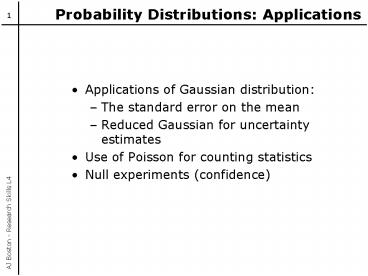Probability Distributions: Applications - PowerPoint PPT Presentation
1 / 18
Title:
Probability Distributions: Applications
Description:
Phone calls are received at Mandy's residence as a Poisson process with ... If Mandy takes a 10 minute shower, what is the probability that the phone rings ... – PowerPoint PPT presentation
Number of Views:47
Avg rating:3.0/5.0
Title: Probability Distributions: Applications
1
Probability Distributions Applications
- Applications of Gaussian distribution
- The standard error on the mean
- Reduced Gaussian for uncertainty estimates
- Use of Poisson for counting statistics
- Null experiments (confidence)
2
Examples of Applications
- We need to find the best estimate of the object
length. - The errors in this measurement are instrumental ?
the errors are Gaussian. The mean value is - The standard deviation is
- The standard error in the mean
- The best value of the length (17.6150.002)m
3
Special case Poisson
- In counting experiments uncertainties are best
described by Poisson statistics. - Statistical fluctuations are independent of time
the resulting errors are called statistical
errors. - The best estimate of mean per unit time in
Poisson statistics - Variance of the sample mean, , is given by
the variance of the parent distribution, s,
divided by the sample size, N
4
Special case Poisson
- Remember for the Poisson distribution, the
variance is equal to the mean, the variance of
the sample mean is therefore, - And the standard deviation of the mean is,
- Where m is the average per unit time.
5
Poisson Example
- Determination of count rates and their errors
- The follow measurements of counts/min were made
from a GM tube viewing a 22Na source.
2201,2145,2222,2160,2300 - What is the decay rate?
- Using Poisson estimators
- The standard error on the mean
- The best estimate of the decay rate
(220621)counts/min
6
Poisson Example
- What would have happened if we had instead
counted for one five minute period? - 11028 counts. Constitutes sample N1
- Mean count rate for 5 minutes is 11028.
- The error is
- Number of counts/min 220621, identical to
before. - A common error to avoid is to calculate the
counts per minute and then take the square root
of this number.
7
Poisson Examples
- Phone calls are received at Mandys residence as
a Poisson process with parameter l2 per hour? - If Mandy takes a 10 minute shower, what is the
probability that the phone rings during that
time? - Probability of a ring (or more than once) 0.284
8
Gaussian Further examples
- If we measure the speed of sound in an experiment
to be 38020m/s. We would like to know how
consistent our measurement is with a theory which
predicts it to be 340m/s. - We need to consider the fractional area under the
tails of the Gaussian distribution, or the area
with t greater that some specified value of r,
where t is the distance from the mean, measured
in standard deviation units. - You can determine tgtr or tgtr, the former gives
the area in the tail of one side of the symmetric
distribution. This is useful when you have
xDx1and x-Dx2. At r0 the probability or area of
one tail is just half that of two tails.
9
Factional area under tail
t0
-r
r
10
Integrated Gaussian distribution
11
Fractional area under tail
- In this example
- The corresponding probability is 4.6 (from
table). - If 1000 experiments were performed, we would
expect 46 of them would differ from the predicted
value by at least as much as ours.
12
Confidence limits and Null Experiments
- Setting confidence limits when no counts are
observed - Many physics experiments test the validity of
certain theoretical conservation laws, by the
search for reactions of decays forbidden by these
laws. - If a observation is made for a certain amount of
time, if one of more events are observed the
theoretical law is disproved. - If NO events are observed the converse is NOT
true. - Instead the limit on the lifetime of the reaction
or decay is set.
13
Null experiments
- If the process has some mean reaction rate, l,
then the probability of observing no counts in
the time period, T, is - Remember, P(0l) can be interpreted as the
probability distribution for l when no counts are
observed in a period T. - Question What is the probability that l is less
than some value lo?
14
Null experiments
- Question What is the probability that l is less
than some value lo? - This probability is known as the confidence level
for the interval between 0 and l0. To make a
strong statement we chose a high confidence level
(CL) for example 90 (CL0.9).
15
Null experiments Example
- 50g of 82Se is observed for 100 days, to look for
a neutrino-less double beta decay a reaction
normally forbidden by lepton conversion. However
theory suggests this process may occur. - The apparatus has a detection efficiency of 20.
No events were recorded. - For 90 confidence
- For 50g sample, the total number of nuclei is
- Limit on decay rate/nucleus is
- The lifetime is just the inverse of l
16
Summary of lecture 4
- Applications of Gaussian distribution
- The standard error on the mean
- Reduced Gaussian for uncertainty estimates
- Use of Poisson for counting statistics
- Null experiments (confidence)
17
Summary of Excel Probability Functions
- Binomial
- BINOMDIST(r,N,p,false)
- Poisson
- POSSON(x,m,false)
- Gaussian
- NORMDIST(x,m,s,false)
18
Gaussian probability































